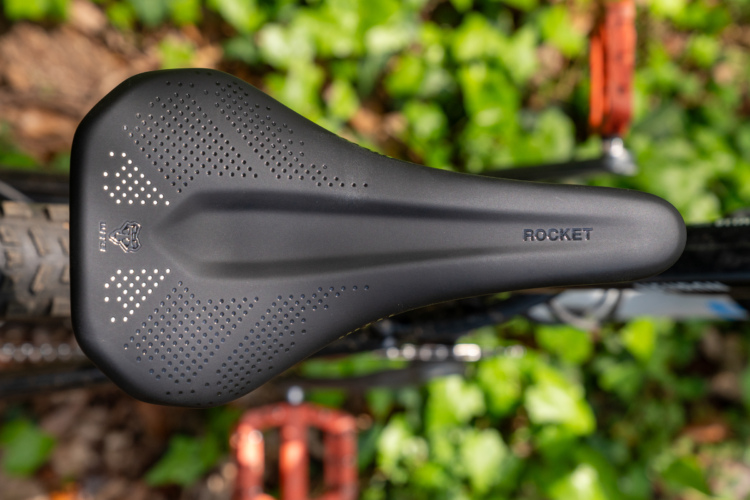
This new RockShox Reverb AXS wireless electronic dropper solves the issue of batteries hitting the rear tire on smaller frames, it has more travel options, and it fits more bikes. All that cable-free tech comes at a cost of $549 (€600 VAT included), down from $645 for the previous version.
RockShox Reverb AXS specs
- Wireless electronic, uses same battery as Eagle Transmission
- 30.9, 31.6, and 34.9mm diameters
- 100, 125, 150, 175, 200, 225, and 250mm travel options
- Weight: 695g as tested (31.6x175mm)
- Price: $549
- Buy from Jenson USA and Worldwide Cyclery
As ever, the SRAM app will tell riders what size post fits their bike and legs. These robo-droppers come in 100, 125, 150, 175, 200, 225, and 250mm (!) travel options, and 30.9, 31.6, and 34.9mm post diameters. The 175mm post we have measures 392.2mm from base to saddle clamp when fully extended, and it weighs 695 grams (post only). Compare that to the 30.9x200mm Fox Transfer Neo we tested, which weighed 714g (post only).
Install notes
Mounting this post is a key selling point. Plug it into the bike, measure height, tighten the frame clamp and saddle rails, pair it with any AXS controller, and go ride. You could even mark the height and use one post for multiple bikes if the frame allows. The AXS Reverb is pumped with max pressure out of the box to further simplify things.



Up/down performance
Several years ago I tested the Magura Vyron wireless dropper and was bemused by the delayed responsiveness. This Reverb AXS dropper responds as fast as any cable-actuated dropper, with no noticeable delay whatsoever. Since there’s no cable to soil and slow down, it actually seems more responsive than some of my dropper posts. Ask and ye shall receive.
The Fox Transfer post and Specialized Command Post audibly stand out in my brain, as both top out with a loud clack to let you know they’re ready for sitting. Reverb posts are now just as percussive at full height. You’ll never wonder if your post returned to full mast; it confidently informs you.
With an air-over-air system similar to other suspension components, the Reverb sits solid under your rump. There’s no wiggle or squish at top-out, and yes, you can hang or lift your bike from the saddle when the post is compressed. It takes a sturdy yank to raise the post by hand, and it should stay put in the bike stand no matter how heavy your bike gets.
SRAM has developed something called ActiveRide that gives the AXS Reverb a little cushion when it’s not fully extended. They say this slight movement smooths out the ride for folks who like to climb with their saddle a little lower, which seems to be particularly targeted toward e-bikers. I ride with my saddle fully up or down and didn’t notice this feature until I read about it. I can see the benefit for uber-technical climbs when you want a little bend in your knees, but it’s not a feature I’ve ever found myself asking for. How about you? Let us know in the comments if you’d like a little cushion in your dropper occasionally.


Lever thoughts
It seems the person who designed cyber trucks might have had a hand in drawing this AXS dropper lever. It works great and feels fine on my thumb, but aesthetically it’s half-baked at best. With SRAM’s sleek new brake and shift cable routing, and longtime focus on reducing handlebar clutter, this thing sticks out like an afterthought. Not only is the lever a plastic blob, but the included bar mount doesn’t pair with their clean MMX clamps. It’s likely there will be ten after-market lever solutions available in the next few months.
Maintenance
We looked at the maintenance docs and this thing looks pretty simple to service every 300 hours. It’s about as complicated as cleaning and re-lubricating your fork’s air chamber, and there’s a good chance you already own the tools to make it happen.
How many batteries can I add to my bike? Well, once you have one, you might as well have another. That way, when your derailleur battery dies, you can shift with your dropper battery, swapping back and forth when the dropper needs slamming. In about a month and a half of testing I haven’t had to charge the battery, and I’d be comfortable taking this thing on a big backcountry ride.
Though the post ships at max pressure, it’s possible to adjust the pressure at home, which could be particularly helpful for lighter riders who have a hard time compressing the post. RockShox notes you’ll “need a pump with a 600psi max pressure allowance to adjust the pressure in the post,” so a regular shock pump probably won’t do the job.

Pros
- No cables to jam or corrode
- Battery placement is better for smaller frames and shorter legs
- Super simple setup
- Fast and positive actuation
- Home serviceable
- 250mm option is the longest available, besting the 240mm OneUp V3 post
Cons
- Lever does not integrate with other SRAM cockpit clamps
- Expensive, but $300 less than the Fox Transfer neo
- Not lightweight
- Batteries
Bottom line
A good number of dropper-post issues arise from cable bends and blockages, and the RockShox Reverb AXS eliminates these problems while delivering reliable performance on the trail.





















3 Comments
1 week ago
1 week ago
1 week ago